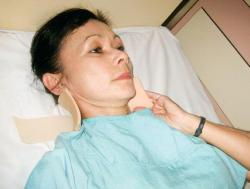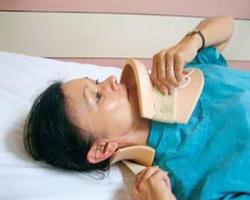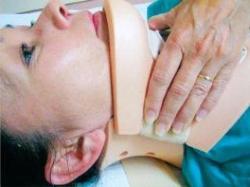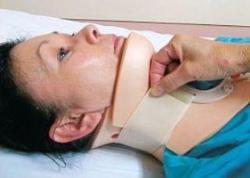Philadelphia neck collar
What is a Philadelphia neck collar?
Cervical (neck) collars help to immobilise the neck. They are used to prevent neck flexion (forward movement), extension (backward movement) or rotation (sidewards movement) of the cervical spine.
A Philadelphia neck collar is a rigid, non-toxic hypo allergenic, latex-free foam collar that provides rigid plastic support in front and behind your neck. It is designed to provide support to the cervical spine by preventing any movement while healing is taking place.
The cervical spine
The cervical spine is made up of the first 7 bones of the spinal column and is located at the bottom of the skull down to just above the shoulders (thoracic spine).
The spinal column also includes joints, discs, ligaments, tendons, nerves and the spinal cord. Each bone is shaped in a special way to allow the bones to stack together and protect the spinal cord from damage.
The cervical spine:
- supports the weight of the head.
- protects the spinal cord.
- allows for rotation of the neck (moving the neck side to side).
- allows for flexion/extension (move the neck up and down).
Injuries
An injury to the cervical spine can result in:
- fractures (broken bones)
- dislocations (bones that move away from the normal position)
- subluxations (incomplete dislocations)
- damage to joints, ligaments and tendons.
Some injuries can take up to 3 months to heal.
Surgery may be required to treat some injuries.
Diagnosis of injuries
Injuries are diagnosed using X-rays and/or MRI and CT Scans. For healing to take place it is important that the spine remains in the correct position and the injury is stabilised.
Who will fit your collar?
A doctor, experienced spinal nurse, orthotist or physiotherapist may be involved in fitting your collar. Please do not allow unqualified people to make any changes or adjustments to your collar.
Always consult with experienced staff if adjustments are required.
How to apply your collar
The Philadelphia Collar consists of a front and back piece.
Step 1

While still lying down on your back slide the back piece under your neck from the side. Please do not lift your head.
Step 2

Apply the front piece ensuring it sits under your chin so your chin is firmly supported.
Step 3

Ensure both sides of the front piece of collar fits neatly over the top of the back portion so that the front piece lines up with the back.
Step 4

Bring the Velcro straps on either side from the back piece forward and secure over both sides of the front piece.
When to wear your collar
You should wear your collar when you are:
- in bed
- in the shower
- sitting
- walking
- in the car.
It is usual to wear your collar continuously. Please check with your spinal doctor for any different instructions and when you can stop wearing your collar.
Care of your collar
Your collar can be sponged each day using a cloth with warm water and soap and patted dry with a towel. This will remove sweat, dirt and grime. Reapply your collar as per instructions. Do not place near a heater or use a hair dryer to dry.
Activities to avoid while wearing your collar
While you are wearing your collar you should not:
- play physical sports or run
- drive a motor vehicle
- lift heavy items
- do any manual work.
You should also avoid attempting to bend your head or neck in any direction while wearing the collar.
Consult with your spinal doctor as to when you can resume normal activities.
Other considerations
- Be careful around small pets and children
- Keep your environment free of obstacles such as mats, cords, and rugs that you may trip over.
- Wear comfortable practical shoes (no thongs, high heels or slippery soles).
- Report any skin problems that develop while wearing your collar.
- A follow up appointment will be made with your spinal doctor prior to you being discharged from hospital.
Where to get help
- Contact the hospital or health facility where you were given your collar.
- See your doctor.
- Visit a GP after hours.
- Ring healthdirect Australia on 1800 022 222
Acknowledgements
Royal Perth Hospital
This publication is provided for education and information purposes only. It is not a substitute for professional medical care. Information about a therapy, service, product or treatment does not imply endorsement and is not intended to replace advice from your healthcare professional. Readers should note that over time currency and completeness of the information may change. All users should seek advice from a qualified healthcare professional for a diagnosis and answers to their medical questions.